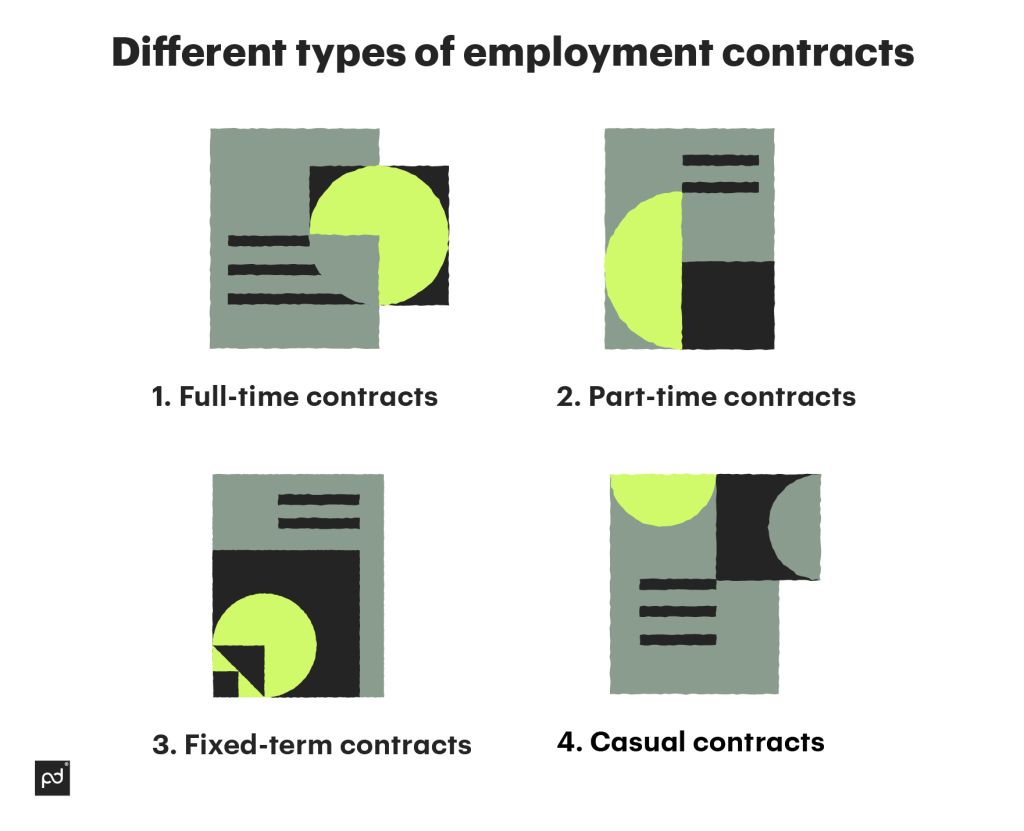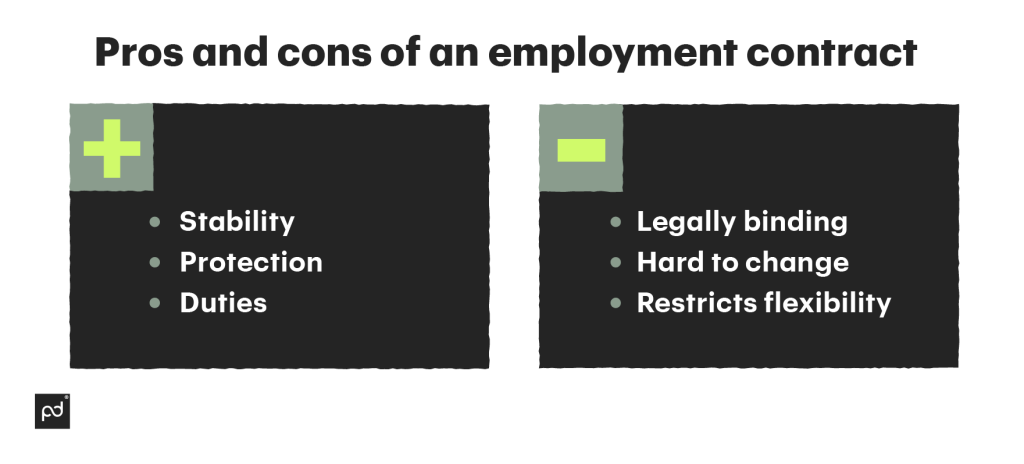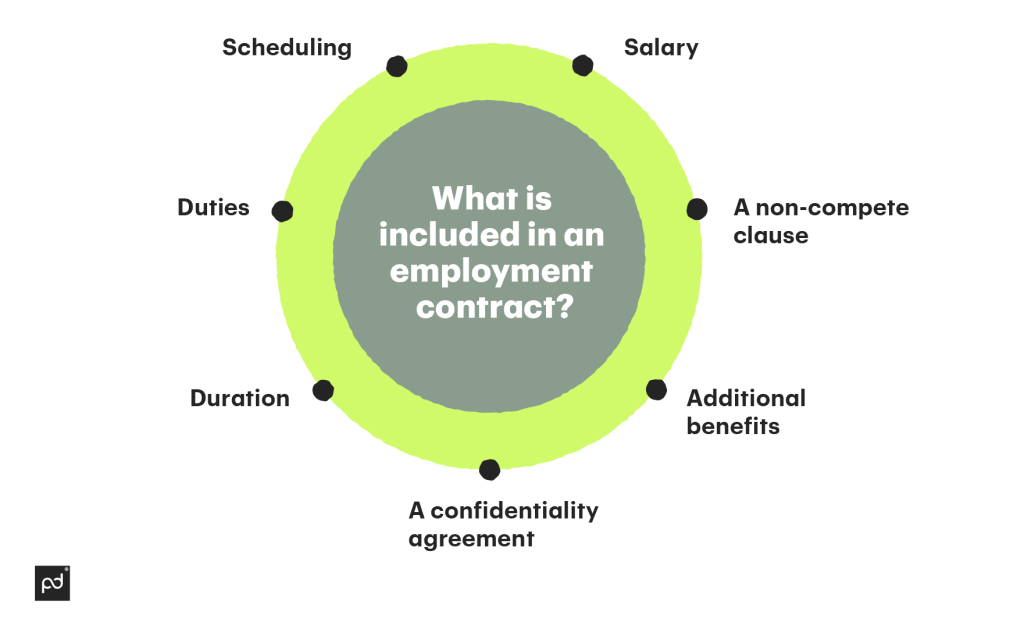When you hire new staff, it’s important to understand the different types of employment contracts that are around, and which best suit you and your employees’ needs.
We’re going to outline your options, what you should be thinking about, and how to ensure your contracts are properly put together.
What is an employment contract?
An employment contract is an agreement between two parties — the employer and the employee — that outlines and defines the working relationship between them.
It serves as a roadmap that lets each party know their obligations to the other and what they have to do to fulfill the terms of the contract.
An employment contract will contain various clauses, as well as terms of employment that are common to all contracts, such as the salary to be paid.
It may outline details that are specific to your business type and the role to be carried out by the employee, too.
Any employee contract should be agreed upon by both parties before signing.
Different types of employment contracts
There can be different types of employment contracts according to factors such as employee role, business type, and whether workers are full-time employees or part-time.
Some of the main types of employment contracts include the following.

1. Full-time employment contracts
While there’s no precise definition regarding how many hours are meant by full-time, this usually implies somewhere in the region of 30 – 40 per week.
However, this may be greater according to factors such as location and business type.
A full-time employment contract will include details of the person’s role, the salary paid, hours to be worked, and other benefits included.
In most cases, it will not have an end date; when it does, it’s known as a fixed-term contract or permanent employment contract.
Full-time contracts offer benefits to each party.
To the employer, they show the employee’s commitment to your business in terms of their ongoing participation in tasks and projects.
For permanent employees, they offer greater job security and the potential to grow, seek further training, and advance in their careers compared to fixed-term employees.
2. Part-time employment contracts
As with full-time contracts, there’s no precise definition regarding how many hours part-time contracts cover.
The number of hours may also be flexible, and employees may be asked to work longer hours in some cases, such as when a business needs to meet seasonal demand for its products.
Depending on state/federal laws, part-time employees may receive all the benefits their full-time counterparts do.
Although, of course, if they’re on the same salary structure, their wages will be on a pro-rata basis.
Many employers pick part-time workers who already have the prerequisite skills and don’t need expensive or extensive training and onboarding.
3. Fixed-term contracts
As briefly mentioned earlier, fixed-term employment contracts are where there is an agreed start date and end date.
The length of these can vary greatly and encompass both part-time and full-time hours. If the latter, then a short-term worker should receive all the benefits their full-time, long-term colleagues do.
Fixed-term contracts are an ideal solution in scenarios where existing employees take long-term leave or maternity leave.
They can also be helpful if you experience seasonal fluctuations in demand or have a special project that is time-limited.
Depending on business needs (and applicable laws), such contracts can be extended if both parties agree.
4. Casual contracts
Casual employment contracts (or zero-hour contracts in the UK) can cover a range of scenarios, from self-employed freelancers to fruit pickers.
At their heart, they facilitate the need for the employee to be available for whatever hours the employer can offer them each week or month without promising regular work.
Rather than receiving a full-time salary (or being paid pro rata), they’re paid either an hourly rate or a task-based rate.
A casual contract allows employers the freedom to hire independent contractors according to business needs.
This means they can take on casual employees only when they require them, which can be of great benefit if a business sees a lot of fluctuation.
Using a temporary employment contract template can help you effectively set out the conditions for casual or temporary workers.
Why are employment contracts important?
There are many reasons why having employment contracts is essential.
While they may at times seem complicated, you don’t actually need any legal experience or input to create one.
Using readily available employment contract templates, it’s a simple process to pull one together.
A good employment contract not only defines the employment relationship between company and worker but also clearly sets out the expectations the employer has, from hours to be worked to duties to be carried out.
This allows you to effectively manage staff and protect your business interests.
For example, if an employee doesn’t meet expectations, there should be clauses that cover this.
An employment contract also safeguards the interests of the employee beyond any protection offered by applicable laws and regulations.
The two main factors that make these contracts important are that they guarantee job security for the employee while ensuring there is labor provision for the employer.
Depending on the employer, the contract may set out precise parameters as to the duties the new employee has to carry out, especially when these are specialized.
Of course, there’s always a degree of flexibility, and unless stated otherwise, employees can be asked to carry out other tasks as well.
The contract may outline employment rights too; both those granted by the employer and those enshrined in state or federal laws.
Ensuring a contract complies with any relevant employment laws and/or regulations is crucial.
For instance, the contract should identify whether it’s at-will employment or not.
Meaning, whether the employee can be dismissed at will and without warning as long as the reason is not illegal.
Pros and cons of an employment contract
As with anything in business, there are pros and cons associated with employment contracts.
Knowing these will help you pull together a document that meets the needs of you and your employees.

Pros
1. Stability
With a well-constructed employment contract, stability is guaranteed for both parties.
The employee knows they have job security, whether as part of a long-term, full-time contract or for a fixed term.
The employer, on the other hand, is reassured that they have the manpower to carry out work related to their business needs.
2. Protection
While applicable laws may offer protection to employers and employees, employment contracts add an extra layer of safeguarding.
There may be agreement on aspects of the contract such as required notice periods or holiday pay that supersede those contained in the law.
These protective elements allow both parties to be confident in their roles.
3. Duties
The duties set out in an employment contract don’t only refer to tasks to be carried out by the employee. They can also refer to the responsibilities an employer has.
For example, an employer may include clauses such as performance reviews and career advancement opportunities within the contract.
Cons
1. Legally binding
Once an employment contract has been signed, both parties are bound by the conditions in the contract as well as any laws and regulations governing employment status in your state.
That means there may be repercussions should either party break the conditions contained therein.
2. Hard to change
Once a contract has been signed, it can be difficult to change any of the conditions.
To do so, both parties would have to agree to the changes (or rectify mistakes) and then an addendum to the contract would need to be drawn up, agreed upon, and signed.
3. Restricts flexibility
As an employment contract is legally binding, neither party can leave it just because they feel like doing so.
They have to follow stipulations such as agreed notice periods or the sending of an official termination letter unless they reach an agreement on deviating from the conditions set out.
What is included in an employment contract?

An employment contract can include many unique clauses and conditions depending on the business type and the employee’s role.
However, there are some common aspects of most (if not all):
- Salary. The contract should set out the wage structure accepted by the employee. This could be an annual figure or hourly rate or, in some cases, a rate based on a specific task, such as a figure per word for freelance writers. It should also identify the minimum wage an employee is entitled to.
- Scheduling. The contract should specify how many working hours an employee is expected to work and the parameters of those hours. That may include identifying what days an employee will work, whether those regular hours include occasional or rotated night shifts, the potential for overtime, and if there’s additional recompense for working “unsociable” hours.
- Duties. This section should clearly identify the main responsibilities of the employee, as well as any additional duties they may be called on to perform. It should set out the employer’s responsibilities to their employee, too, such as training and career advancement opportunities.
- Duration. Any employment contract should define the period of employment. That may be an agreed-upon fixed period or it may be ongoing. It should identify whether contract renewal is automatic and whether it’s subject to any conditions (such as a successful performance review). It may also identify whether there’s a probationary period.
- A confidentiality agreement. Some businesses deal with confidential information, intellectual property, and similar, so they may ask employees to sign a confidentiality agreement or NDA (non-disclosure agreement).
- Additional benefits. As well as stating salary details, an employment contract should list employee benefits such as paid holidays, entitlement to time off, insurance payments, pension fund contributions, and so on. These may increase according to the amount of time the employee has been with the company.
- A non-compete clause. In some cases, an employer will not want an employee to take their skills, experience, and knowledge to a direct competitor, even if they lose their role as a result of redundancy. A non-compete clause will typically run for a set period of time.
What is an implied contract in employment?
An implied contract is an oral contract that occurs when an agreement regarding employment or promotion is made verbally or originates in a work-related handbook or manual.
These contracts could also come from previous actions on the part of the employer, such as statements made.
So, during an interview or performance review, the employer (or their representative) may say something that implies the employee will get a certain position or promotion.
While legally binding in most circumstances, an implied contract can be difficult to prove if there’s a dispute.
Customizable templates for various types of employment contracts
As you can see, an employment contract offers advantages and protection to employers and employees.
While some aspects of the employer-employee relationship may be protected by local/national laws and regulations, a well-formulated contract adds additional protection and carefully defines certain aspects of the relationship.
While it may sound complex to put together a good employment contract, the reality is that your human resources department can easily whip one up using the free employment contract template offered by PandaDoc.
By following these template guidelines, and having a checklist of the different factors you want to cover in your employer-employee relationship, you can easily construct a robust and effective contract.
PandaDoc templates take the hard work out of putting together a solid and legally binding document.
They contain all required legal language, meaning you only have to fill in the relevant details.
Not only are these efficient templates simple and intuitive, but they can save you money on hiring a law firm every time you need a new type of contract — something small businesses, in particular, should take note of.
Disclaimer
PandaDoc is not a law firm, or a substitute for an attorney or law firm. This page is not intended to and does not provide legal advice. Should you have legal questions on the validity of e-signatures or digital signatures and the enforceability thereof, please consult with an attorney or law firm. Use of PandaDocs services are governed by our Terms of Use and Privacy Policy.


